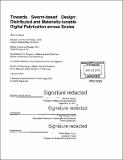| dc.contributor.advisor | Neri Oxman. | en_US |
| dc.contributor.author | Kayser, Markus (Markus A.) | en_US |
| dc.contributor.other | Program in Media Arts and Sciences (Massachusetts Institute of Technology) | en_US |
| dc.date.accessioned | 2018-05-23T16:32:44Z | |
| dc.date.available | 2018-05-23T16:32:44Z | |
| dc.date.copyright | 2018 | en_US |
| dc.date.issued | 2018 | en_US |
| dc.identifier.uri | http://hdl.handle.net/1721.1/115741 | |
| dc.description | Thesis: Ph. D., Massachusetts Institute of Technology, School of Architecture and Planning, Program in Media Arts and Sciences, 2018. | en_US |
| dc.description | Cataloged from PDF version of thesis. | en_US |
| dc.description | Includes bibliographical references (pages 141-149). | en_US |
| dc.description.abstract | Submitted to the Program in Media Arts and Sciences, School of Architecture and Planning, on December 8, 2017 in Partial Fulfillment of the Requirements for the Degree of Doctor of Philosophy in Media, Arts and Sciences at the Massachusetts Institute of Technology Throughout history, Nature has always been part of the discourse in Design theory and practice. The Digital Age in Design brings about new computational tools, redefining the role of Nature in Design. In this thesis, I aim to expand the role of Nature in Design and digital fabrication by investigating distributed fabrication strategies for the production of constructs that are, at once, large in scale and materially tunable towards swarm-based design. Digital fabrication approaches can be classified with respect to two basic attributes: (1) the degree of material tailorability, and (2) the level of collaboration between fabrication units. Conventional manufacturing is typically confined to only one of these attribute axes, with certain approaches utilizing complex tunable materials but virtually no collaboration, and others assembling pre-fabricated building blocks with high levels of intercommunication between fabrication units. A similar pattern is mirrored in biological systems: silkworms, for example, deposit a multifunctional tunable material with minimal communication between organisms; while ants, bees and termites operate as multi-agent communicative entities assembling larger constructs out of simple, unifunctional, 'generic' materials. The purpose of this thesis is to depart from these uniaxial manufacturing approaches and develop a novel swarm-inspired distributed digital fabrication method capable of producing tunable multifunctional materials that is also collaborative. This research merges fiber-based digital fabrication and swarm-based logic to produce a system capable of digitally fabricating complex objects and large-scale architectural components through a novel multi-robotic fabrication paradigm. I hypothesize that this design approach-its theoretical foundations, methodological set up and related tools and technologies-will ultimately enable the design of large-scale structures with high spatial resolution in manufacturing that, like biological swarms, can tune their material make-up relative to their environment during the process of construction. Building on the insights derived from case study projects, fabricating with silkworms, ants, and bees, I demonstrate the design and deployment of a multi-robotic system erecting a 4.5-meter tall structure from fiber composites This thesis addresses the current limitations of digital fabrication, namely: (a) the material limitation, through automated digital fabrication of structural multi-functional materials; (b) the gantry limitation, through the construction of large components from a swarm of cooperative small scale robots; and (c) the method limitation, through digital construction methods that are not limited to layered manufacturing, but also support free-form printing (i.e. 3D-printing without support materials), CNC woven constructions and digitally aggregated constructions. | en_US |
| dc.description.statementofresponsibility | by Markus Kayser. | en_US |
| dc.format.extent | 149 pages | en_US |
| dc.language.iso | eng | en_US |
| dc.publisher | Massachusetts Institute of Technology | en_US |
| dc.rights | MIT theses are protected by copyright. They may be viewed, downloaded, or printed from this source but further reproduction or distribution in any format is prohibited without written permission. | en_US |
| dc.rights.uri | http://dspace.mit.edu/handle/1721.1/7582 | en_US |
| dc.subject | Program in Media Arts and Sciences () | en_US |
| dc.title | Towards swarm-based design : distributed and materially-tunable digital fabrication across scales | en_US |
| dc.title.alternative | Distributed and materially-tunable digital fabrication across scales | en_US |
| dc.type | Thesis | en_US |
| dc.description.degree | Ph. D. | en_US |
| dc.contributor.department | Program in Media Arts and Sciences (Massachusetts Institute of Technology) | en_US |
| dc.identifier.oclc | 1036986779 | en_US |
